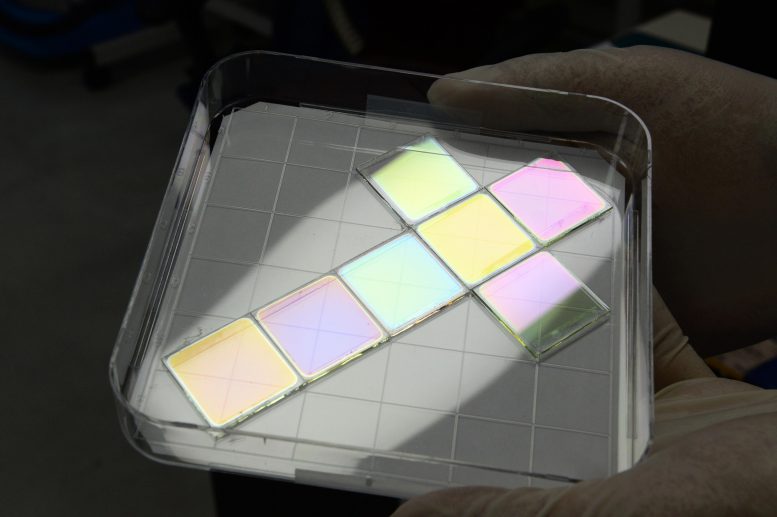
The eco-friendly color CIGS thin film solar cells developed by ETRI researchers. Credit: Electronics and Telecommunications Research Institute (ETRI)
Research on solar cells to secure renewable energy sources are ongoing around the world. The Electronics and Telecommunications Research Institute (ETRI) in South Korea succeeded in developing eco-friendly color Cu(In,Ga)Se2 (CIGS) thin-film solar cells.
CIGS thin-film solar cells are used to convert sunlight into electrical energy and are made by coating multiple thin films on a glass substrate. They have a relatively higher absorption coefficient among non-silicon based cells, resulting in high conversion efficiency and long stability. Also, they require less raw materials compared to silicon-based cells; hence less process and material costs.
One downside has been the difficulty in commercialization as they use the buffer layer which contains toxic heavy metal, cadmium. Thus, the ETRI team replaced the cadmium sulfide (CdS) buffer layer with zinc (Zn) based materials — which is not harmful — and managed to achieve approximately 18% conversion efficiency; thus eliminating the obstacle to commercialization.
Likewise, the availability of more than 7 colors including purple, green, and blue — without the need for additional process or cost — means one step closer to full-on commercialization. Moreover, the researchers succeeded in identifying a new analysis method using photo-pumping terahertz spectroscopy and a mechanism for improving the conversion efficiency of solar cells with Zn-based buffer layers.
The solar cells are only 3? thick and can be coated on a flexible substrate as well as a glass substrate. This means that they could be bent or folded, expanding applications as a next-generation eco-friendly energy source.
“This technology will contribute to the solar power system development through the production of high value-added color photovoltaic modules,” said Yong-Duck Chung, the ETRI principal researcher.
The excellence of the research was proven by its publication in ‘Nano Energy’ and ‘Progress in Photovoltaics: Research and Applications’ as the cover article, globally esteemed international journals in the energy sector.
Reference: “Ultrafast wavelength-dependent carrier dynamics related to metastable defects in Cu(In,Ga)Se2 solar cells with chemically deposited Zn(O,S) buffer layer” by Woo-Jung Lee, Dae-Hyung Cho, Jung Min Bae, Myeong Eon Kim, Jaehun Park and Yong-Duck Chung, 13 May 2020, Nano Energy.DOI: 10.1016/j.nanoen.2020.104855
ETRI is a non-profit government-funded research institute. Since its foundation in 1976, ETRI, a global ICT research institute, has been making its immense effort to provide Korea a remarkable growth in the field of ICT industry. ETRI delivers Korea as one of the top ICT nations in the World, by unceasingly developing world’s first and best technologies.